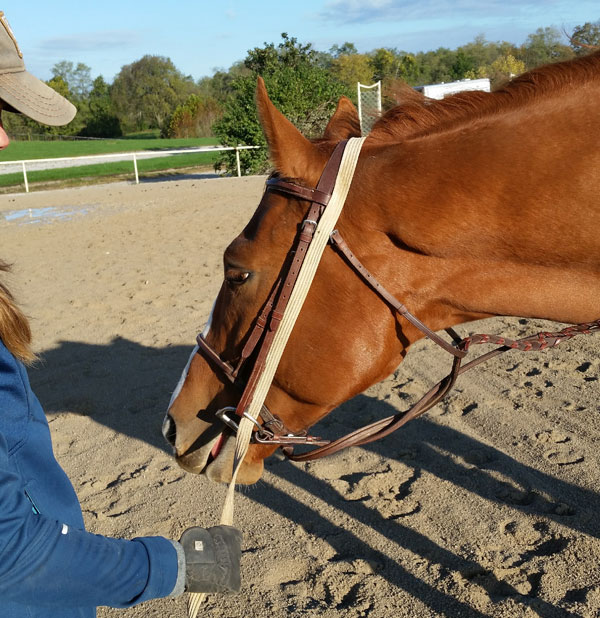
Longeing isn’t just a way to let your horse burn off excess energy before getting down to the business of riding; it can be an effective training and conditioning tool in and of itself.
Tack-tical Approach
The equipment you use to longe your horse in is up to you. Some riders outfit their horses in leg wraps and bell boots; others choose to leave their horse’s legs bare. It goes without saying that a horse should be longed on ground that is not slippery and that he should be worked in a large enough circle that he’s not struggling to keep his footing.
Horses can be lunged in a longeing cavesson, a halter or a bridle. What your horse wears when he’s longed is personal preference, but it’s imperative that you know how to use the tack correctly.
A longeing cavesson looks like a cross between a bridle and a halter, and it’s designed to not twist on the horse’s face like halters can. A cavesson has several rings on it, including where a bit and side reins attach. The longe line attaches to the center ring on the noseband.

If your horse will be wearing a halter, snap the end of the line to the ring under his chin. If your horse is wearing a bridle, you’ll need to make sure he doesn’t inadvertently step on or through his reins if he stretches down his neck or throws in a few good bucks. To do this, simply twist the reins while they are not over his head, undo the throat latch and run it through the twisted reins. This way, you don’t have to undo the rein buckle, but you can ensure he won’t be able to get into trouble.
When attaching the longe line, never clip it directly to the bit, as this can be too harsh on a horse’s mouth. Instead, run it from the outside in on one side of the bit, up over the poll, down the other side of the horse’s face and attach it to the other side of the bit. You will need to switch the side the longe line is on when you change direction.
Longeing Basics
When teaching your horse to longe, it’s important that you have a longe whip. Take time to desensitize your horse to the whip if he seems anxious or afraid of it. The whip is generally to encourage forward movement and show the horse where you want him to go—it should never be used as punishment.
The excess longe line should not be left trailing on the ground where you might step in it and get caught; it should be folded in your hand so your fingers won’t get caught if the horse gets fractious and pulls away.
Ideally, you should not have to move much while the horse moves in a circle around you. Your whip will always be carried in the hand that is closest to the horse’s haunches; it should be pointing down when not in use. Body language is the key to longeing: with your body (and whip) behind the horse, he should move forward. If you’re in front of his shoulder, he should slow or stop.
Begin by halting your horse and feeding out a bit of the line, tell him to “walk” and raise your whip until it points at his hip. You may need to snap the whip to get him to move both forward and out. Meter out the lunge line until he gets to the size circle you would like him to be on. Once he is at the distance you would like, walk in a small circle, making sure you are staying behind his shoulder to keep the forward motion.
To move up in gait, verbally command the horse (“trot”) and be ready to crack the whip. To slow down a gait or to stop, make the verbal command and step in front of his shoulder to indicate you would like to slow the forward motion.
Longeing is a wonderful tool for all riders to have in their toolbox; it can be used in many different capacities to accomplish different goals.
Liked this article? Here are others you’ll love:
Longe Away Tension
General Horse Training Topiclist






My trouble with longe-line is they usually try to turn towards me and stop. I longed my mare in the round pen for a while then tried longing her outside of it and she picked it up very quick.
Good reminders.
Great article. But I havr a problem. While lounging my gelding he points his head awsy from me. I dont use whips so its not that. I dont know how to lounge in s controlled manner. I am constantly pulling on the line when trotting and cantering.
What do I do to smooth out his gaits?